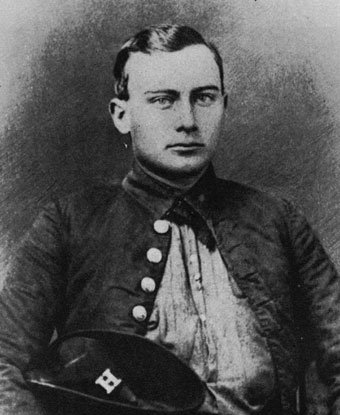Last updated: June 11, 2023
Person
Sam Watkins

A Private in Company H, First Tennessee Infantry, Sam Watkins is today one of the most well-known common soldiers in Civil War history.Despite his low rank, Watkins has found immortality through his 1882 memoir Company Aytch.
Born in Maury County, Tennessee, south of Nashville in 1840, Watkins rushed to enlist in the army when Tennessee left the union in 1861.His unit had served in the mountains of Western Virginia during the brutal winter of 1861-62, and received its baptism of fire at Shiloh that April.Two of the First's sternest tests had come in late 1862 at Perryville, Kentucky in October and at Murfreesboro, Tennessee – only miles from Sam's home – on the last day of the year.Watkins and the First Tennessee fought on both days at Chickamauga, and his account of the chaos in the woods along Brotherton Road on September 19th stands as one of the best accounts of the battle by any participant.
The First Tennessee continued its hard service in the Army of Tennessee through the end of the war, and Watkins recorded his and his comrade's wartime experience for posterity two decades later with his wildly successful memoir.Filmmaker Ken Burns gave Watkins' fame a boost when he used selections from Company Aytch in the popular Civil War documentary (1990).
As enduring a piece of Civil War literature as Company Aytch has been, though, it is not without its limitations.In framing his war narrative, Watkins was careful to exclude any significant discussion of the war's causes and its continuing effects on the Middle Tennessee society in which he lived.The absence of slavery from the memoir is staggering, particularly considering Watkins' background.Census and tax records of antebellum Maury County show that Sam's father, Frederick, owned more than 100 enslaved African Americans on two plantations in the county.The Watkins family was the third wealthiest in one of the most prosperous counties in the state.Incredibly, Watkins was not an outlier in his company.Nearly half of the company with which he left Maury County in 1861 came from slaveowning households.
Nor was the issue of slavery left at home in Tennessee.As many as fifty African American servants were brought into the field to serve the privileged soldiers of the First, Watkins brought a slave of his own, a man named Sanker. As constant a presence as these enslaved men were in the unit, however, Watkins never acknowledged them in the pages of his memoir, effectively purging slavery from his account of the war.Watkins's memoir is a case study in the processes of both remembering and forgetting that help shape what we teach, think, and believe about the Civil War – and a great read as well.
Bibliography
Blight, David W. Race and Reunion : The Civil War in American Memory. Cambridge : Harvard University Press, 2001.
Tennessee, Maury County. 1860 U.S. Census, Population Schedule. Digital Images. Ancestry.com. February 7, 2017. www.ancestry.com.
Tennessee, Maury County. 1860 U.S. Census, Slave Schedule. Digital Images. Ancestry.com. February 7, 2017. www.ancestry.com.
Tolbert, Lisa L. Constructing Townscapes: Space and Society in Antebellum Tennessee.Chapel Hill: University of North Carolina Press, 1999.
